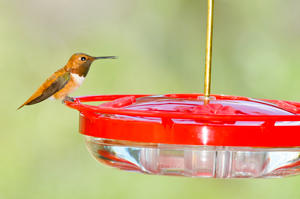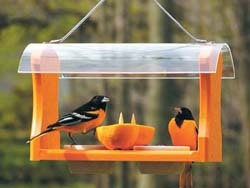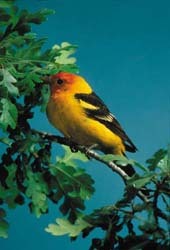
Oh! Things to Know About Orioles
One of North America’s most popular fruit-eating birds is the oriole and we can help you attract them to your yard if they are in your area.
Orioles are known to enjoy orange slices, grape jelly and mealworms offered from tray-style feeders. Nectar feeders can also be used. Boil two cups of water; add 1/3 cup of sugar; cool and fill the feeder. Be patient and keep the foods fresh, replacing them every few days and be sure to keep your feeders clean, too.
Oriole Fun Facts
- When not feeding on nectar, orioles seek out caterpillars, fruits, insects, and spiders.
- The Oriole nest is an engineering masterpiece. They weave a hanging-basket nest with plant fibers, grasses, vine and tree bark and sometimes string or yarn placed out on the small twigs of a branch 6-45 feet in the air. This keeps them safe from most predators.
- The Baltimore Oriole is a common inhabitant of suburban landscapes due to is preference for open settings that are bordered with mature trees.
- Orioles are a member of Icteridae family, meaning that their closest bird relatives include meadowlarks, blackbirds, bobolinks and grackles.
- The oriole gets its name from the Latin aureolus, which means golden.
Hummingbirds, Orioles, Tanagers Oh My!
Cool Bird Alert! Entice hummingbirds, orioles and tanagers with the right foods. The secret to success is having the foods they want available and ready before they arrive.
|

|
Hummingbirds
Hummingbirds are most easily attracted to nectar feeders. Be sure to have nectar feeders out and ready as they are migrating through to their summer breeding grounds.
Hummingbirds remember feeders from last year and will visit those same spots to see if the nectar is available. They will also check out new locations; especially, if the feeders have some red coloration on them. Hummingbirds learn that many red flowers provide quality nectar sources and then show a tendency to check out red colors while foraging.
Residential hummingbirds, the ones that stay in our area to raise families, are more likely to visit feeders on a regular basis if the feeders are available when they move in. Also, place multiple feeders around your yard to make it more difficult for one hummingbird to claim and protect your feeders.
|
 |
Orioles
Orioles are nectar, fruit and insect eaters. While in their tropical winter habitats, Baltimore and Bullock’s Orioles feed on nectar from numerous flowering trees, which explains their attraction to nectar feeders upon their spring-time return to North America.
They usually stay hidden in the trees eating and singing their beautiful whistling notes. They can be drawn down from their perches with foods like nectar, grape jelly, orange slices, mealworms and Jim’s Birdacious® Bark Butter®.
|
 |
Tanagers
Sightings of tanagers are on the rise, including Summer, Scarlet and Western Tanagers. Like orioles, tanagers tend to hide in the trees and are partial to foods like suet, Bark Butter, fruit and jelly.
|





